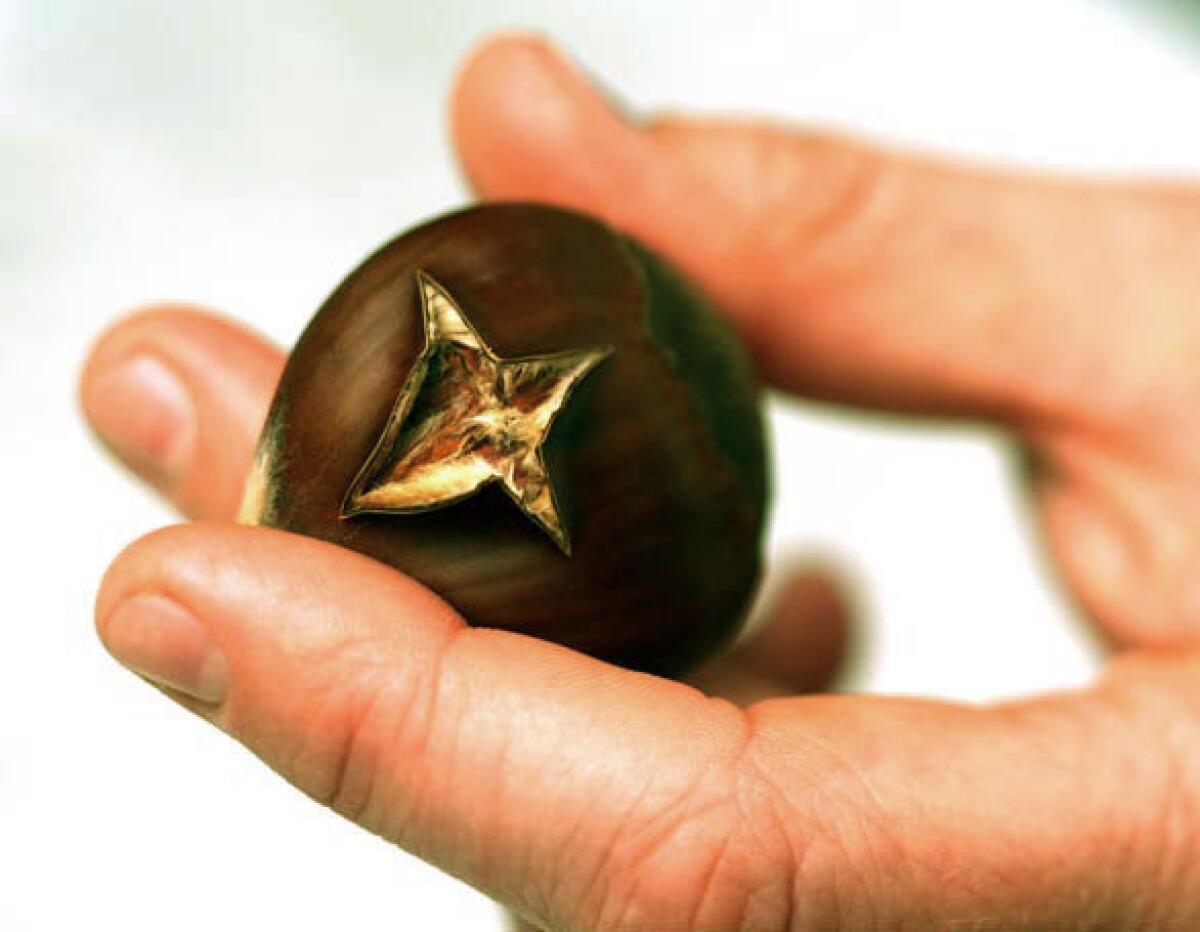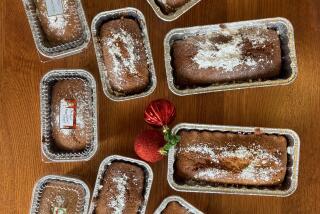Test Kitchen tips: Peeling chestnuts

- Share via
You know the holidays are just around the corner when you start spotting fresh chestnuts in the market. Wonderful as they may be to eat, chestnuts can be tricky to peel, especially if you’ve never worked with them (or are feeling a bit rusty at the start of the season).
Food editor Russ Parsons has a simple but great guide for roasting, peeling and using chestnuts. We also include a step-by-step photo gallery to help you figure out how to score and peel them.
You might also want to consider purchasing a chestnut knife to help you tackle the nuts. The little knife looks a lot like a curved tourné or birds beak knife, though the blade is smaller, with more of a curved point. You can find them at select cooking and gourmet stores; they’re also available online. Prices vary, but a chestnut knife should set you back about $10. They make the whole job of scoring chestnuts so much easier, so you can focus on the important things, like roasting them over an open fire.
If you have any kitchen tips or questions you’d like me to explore, leave a comment below or email me at noelle.carter@latimes.com.
ALSO:
Go behind the scenes at the Test Kitchen
Browse hundreds of recipes from the L.A. Times Test Kitchen
You can find Noelle Carter on Facebook, Google+, Twitter and Pinterest. Email Noelle at noelle.carter@latimes.com.
Chocolate chestnut cake
Total time: 2 hours, 45 minutes, plus overnight chilling time
Servings: 16
Note: Adapted from “Baking: From My Home to Yours” by Dorie Greenspan. Sweetened chestnut spread with vanilla is available at select gourmet and cooking supply stores, as well as online. Edible gold dust is available at cooking and baking supply stores, as well as online.
9 ounces premium-quality milk chocolate (such as Valrhona or Guittard), finely chopped
11 ounces bittersweet chocolate, finely chopped, divided
6 tablespoons plus 1/4 cup sugar, divided
1 cinnamon stick
2 cups plus 2 tablespoons heavy cream, divided
1 1/4 teaspoons salt, divided
10 ounces (2 1/4 sticks) butter, at room temperature
2 cups cake flour
2 teaspoons baking powder
2 sticks (8 ounces) butter, at room temperature
1 1/4 cups plus 1 tablespoon (packed) light brown sugar, divided
4 large eggs, separated
2 teaspoons pure vanilla extract
1 cup store-bought sweetened chestnut spread with vanilla (available in specialty markets and many supermarkets)
1/4 cup whole milk
1/4 cup brandy
16 to 18 fresh or jarred, peeled whole chestnuts (available in specialty markets and many supermarkets), 6 coarsely chopped, the rest left whole
Edible gold dust (optional)
1. To make the ganache, put the milk chocolate and 3 ounces of the bittersweet chocolate in a heatproof bowl. In a medium heavy-bottomed saucepan, stir 6 tablespoons sugar with 2 tablespoons water and the cinnamon stick. Place the mixture over medium-low heat and cook, stirring, until the sugar dissolves. Increase the heat and bring to a boil. Without stirring, boil until the caramel turns a deep amber color, brushing down the sides of the pan with a wet pastry brush to remove any sugar crystals and swirling the pan from time to time. (Depending on the size of your pan, it will take 5 to 7 minutes for the caramel to color properly.) Stand back and add 1 cup plus 2 tablespoons cream and one-fourth teaspoon salt — the mixture will bubble furiously and it might seize, but it will smooth out as you heat it. With the caramel at a boil, whisk it for another minute, or until it is smooth, then pull the pan from the heat and carefully discard the cinnamon stick.
2. Pour the hot caramel over the chocolate and gently stir until the chocolate is melted and the ganache is smooth. Let stand, stirring occasionally, until it is completely cool, about 1 hour.
3. In a stand mixer, preferably with a paddle attachment, or with a hand mixer in a large bowl, beat the butter until smooth and fluffy. Add the chocolate ganache to the butter in four additions, beating on low just until smooth. Scrape the ganache into a container, cover and refrigerate overnight. (The ganache can be made ahead and refrigerated for up to 3 days.)
4. Center a rack in the oven and heat the oven to 350 degrees. Butter a 2-inch-high, 8-inch-square pan, dust the inside with flour, tap out the excess and line the bottom of the pan with parchment paper. Put the pan on a baking sheet.
5. Sift together the flour, baking powder and the remaining teaspoon salt. Working with a stand mixer, preferably with a paddle attachment, or with a hand mixer in a large bowl, beat the butter at medium speed until smooth and light. Add 1 cup of the brown sugar and beat for about 2 minutes. Add the egg yolks one by one, beating after each addition until well blended. Beat in the vanilla extract, chestnut spread and milk. Reduce the mixer speed to low, add the dry ingredients and gently mix them in. If using a stand mixer, scrape the batter into a large bowl and thoroughly wash and dry the mixer bowl.
6. Working in the clean mixer bowl with the whisk attachment or in another large bowl with the hand mixer (and clean beaters), beat the egg whites until they form soft peaks. Add one-fourth cup brown sugar and beat until the peaks are stiff but not dry. Using a large rubber spatula, fold the egg whites into the chestnut batter in three additions. Scrape the batter into the pan.
7. Bake for about 50 minutes to an hour, until the cake is golden on top and a thin knife inserted into the center comes out clean. Transfer the cake to a cooling rack and run a knife around the cake to loosen it from the sides of the pan. Let cool to room temperature in the pan. (The cooled cake can be covered and kept at room temperature overnight.)
8. To make the syrup, stir the brandy and the remaining tablespoon of brown sugar together in a small bowl until the sugar dissolves.
9. To assemble the cake, cut a 7-inch cardboard square for a base. Turn the cake out onto the rack and peel off the parchment paper. Using a long serrated knife and a gentle sawing motion, cut the cake horizontally into two layers. Place the bottom layer cut side up on the cardboard. Brush it with half the brandy syrup, spread it with 1 cup of the ganache and sprinkle with chopped chestnuts. Top with the second layer, cut side up, and repeat with the remaining brandy syrup. Spread ganache over the sides and top of the cake (you may have extra ganache; reserve for another use). Refrigerate the cake while you make the glaze.
10. To make the glaze, put the remaining 8 ounces of bittersweet chocolate in a heatproof bowl. Bring the remaining 1 cup cream, the remaining one-fourth cup sugar and one-fourth cup water to a boil in a medium saucepan, stirring until the sugar dissolves. Remove the pan from the heat, pour the cream over the chocolate and wait 1 minute, then whisk very gently in ever-increasing circles, until the chocolate is melted and the glaze is smooth. Leave the glaze at room temperature until it is thick, but still pourable.
11. To finish the cake, put a cooling rack over a piece of wax paper (the drip catcher) and put the chilled cake on the rack. Pour the glaze over the cake and, using a long metal icing spatula, spread the glaze smoothly across the top of the cake and over the sides. Refrigerate the cake until the glaze sets.
12. To decorate the cake, brush 10 to 12 whole chestnuts with gold dust. Arrange the chestnuts in a diagonal across the top of the cake.
Each serving: 781 calories; 8 grams protein; 74 grams carbohydrates; 3 grams fiber; 54 grams fat; 31 grams saturated fat; 160 mg. cholesterol; 290 mg. sodium.
More to Read
Eat your way across L.A.
Get our weekly Tasting Notes newsletter for reviews, news and more.
You may occasionally receive promotional content from the Los Angeles Times.











